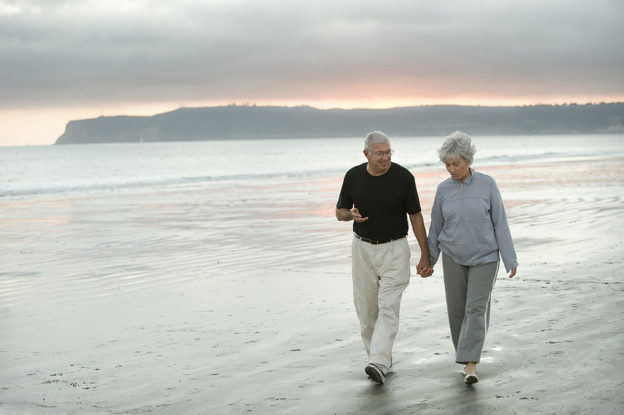By David Blyweiss, M.D., Advanced Natural Wellness
July 8, 2020
There’s a fitness trail at my local park. It’s a mile-long loop where I can get in some regular exercise.
Since I walk briskly, I generally complete the circuit four times in about an hour. During this time, I enjoy taking in the scenery and clearing my mind.
I also enjoy a little bit of people watching!
There are all sorts of folks on the path with me. The real go-getters often pass me by. But a much larger number of walkers appear to be strolling along at a slow and leisurely pace.
They don’t seem to have a care in the world. And by the time I’m finishing my fourth lap, they are just finishing their first!
It makes me want to pull out my business cards and start passing them around.
Why?
Open your arteries, improve blood flow for a new health miracle...
Did you know your circulatory system has over 60,000 miles of arteries, veins and other blood vessels, if stretched end to end?
But as you age, your blood vessels undergo changes, which may cause them to stiffen, thicken and get clogged.
GOOD NEWS! Doctors have now identified a “Miracle Molecule” inside your arteries that helps OPEN your arteries and IMPROVE blood flow.
It’s what Dr. Valentin Fuster calls it, "One of the most important discoveries in the history of cardiovascular medicine."To you, that means...
- Healthy blood pressure
- Sharper mind and memory
- Skyrocketing energy and muscular strength
- Increased pleasure and passion in the bedroom
- Improved circulation to every cell and organ in your body
Go here to discover a new natural way to significantly boost the levels of this miracle molecule in YOUR body NOW!
Because there’s something every single one of these slow walkers should know. I want to help them, but I don’t also don’t want to seem like some kind of medical shyster who creeps around in parks looking for patients.
Still, my mind is racing. I want to shout it out for all to hear:
“Your slow walking pace is influencing how well you age and how long you live!”
Let me explain.
People with slower gait speeds when they are in their mid 40’s tend to look much older than their faster-walking counterparts.
They have accelerated aging in multiple organ systems. Their brain volumes are smaller with more cortical thinning and a greater number of white matter lesions. All of these factors are linked to mental decline and dementia.
In other words, slow paced 45-year-olds are practically geriatric!
Not only that, older folks with slow gait speed have more unplanned trips to the hospital and ER.
Even worse, men and women over 65 who walk the slowest have a 10-year survival rate of just 19-35%. In the meantime, those who walk the most briskly have 10-year survival rates of 87-91%.
Are You Suffering From...
- Love handles and a pot belly
- Romance that isn't what it used to
- Forgetfulness and inattention
- Low (or no) strength and endurance
- A sex drive that's shifted into neutral...or worse
If so...you may have Mature Male Burnout. Click here to discover more about this unique condition and what you can do about it.
Now, that’s quite a difference!
So whenever you walk, don’t stroll. Put a little pep in your step. Turn your slow wandering into a purposeful stride. In other words…
Change the Way You Walk
If you walk slowly out of habit, there is an extremely effective way to get yourself moving faster.
Just listen to high tempo music and time your steps to the beat.(If you prefer not to bring music, try creating your own chant to keep your feet moving faster. I hum Annie Lenox’s “Sweet dreams are made of this” which keeps you moving around 3 miles/hour, or think of the old military cadence: Left, left, left-right-left.)
In many cases, a slower walking speed is due to a loss of muscle mass and bone strength in the legs and lower body. However, there are plenty of ways fix this. Try to incorporate some real strength and bone-building exercises into your daily activities.
For example, practice getting up and down from a chair. This will go to work immediately to build strength in the leg and trunk muscles that are so critical for walking. And it’s easy to do!
Just stand with your back to a sturdy chair. Place your arms straight out in front of you and your feet shoulder-width apart. Bend your knees and slowly lower your rear-end toward the seat of the chair while you count to five. Keep your knees above your ankles and your back straight as you lower yourself.
Once seated, slowly rise out of the seat to a count of three. Repeat ten times, rest for a minute or two, then perform the exercise 10 more times.
Another easy way to improve muscle strength, bone density and balance is by taking part in something called “odd-impact” exercises. The concept is really quite simple…
Instead of walking forward all of the time, try walking backwards, sideways and making frequent turns. Take paths that go uphill, downhill and have multiple twists and cutbacks.
Not only does this increase bone mineral density in the spine and thighbone, it also gives the muscles in these same areas a fantastic workout.
It’s okay to start slowly. You aren’t going to turn from a tortoise to a hare overnight. But with dedication you can increase your gait speed incrementally – as long as you have your doctor’s approval.
In just a few months, these kinds of resistance and coordination exercises can improve gait speed by around 10%. And if you keep pushing forward (sideways and backwards, too!) the results could be phenomenal.
You can get even greater results if you push yourself a little longer and harder every time you walk.
Your health – and your life – could depend upon it.
SOURCES:
Rasmussen LJH, et al. Association of Neurocognitive and Physical Function With Gait Speed in Midlife. JAMA Netw Open. Published online October 11, 2019;2(10):e1913123.
Zarei M, et al. Cortical thinning is associated with disease stages and dementia in Parkinson’s disease. J Neurol Neurosurg Psychiatry. 2013 Aug;84(8):875-81.
Debette S, et al. The clinical importance of white matter hyperintensities on brain magnetic resonance imaging: systematic review and meta-analysis. BMJ. 2010 Jul 26;341:c3666.
Wildes TM. Make time for gait speed: vital to staging the aging. Blood. 2019 Jul 25;134(4):334-336.
Studenski S, et al. Gait speed and survival in older adults. JAMA. 2011 Jan 5;305(1):50-8. Hardy SE, et al.
Hortobágyi T, et al. Effects of Three Types of Exercise Interventions on Healthy Old Adults’ Gait Speed: A Systematic Review and Meta-Analysis. Sports Med. 2015 Dec;45(12):1627-43.







